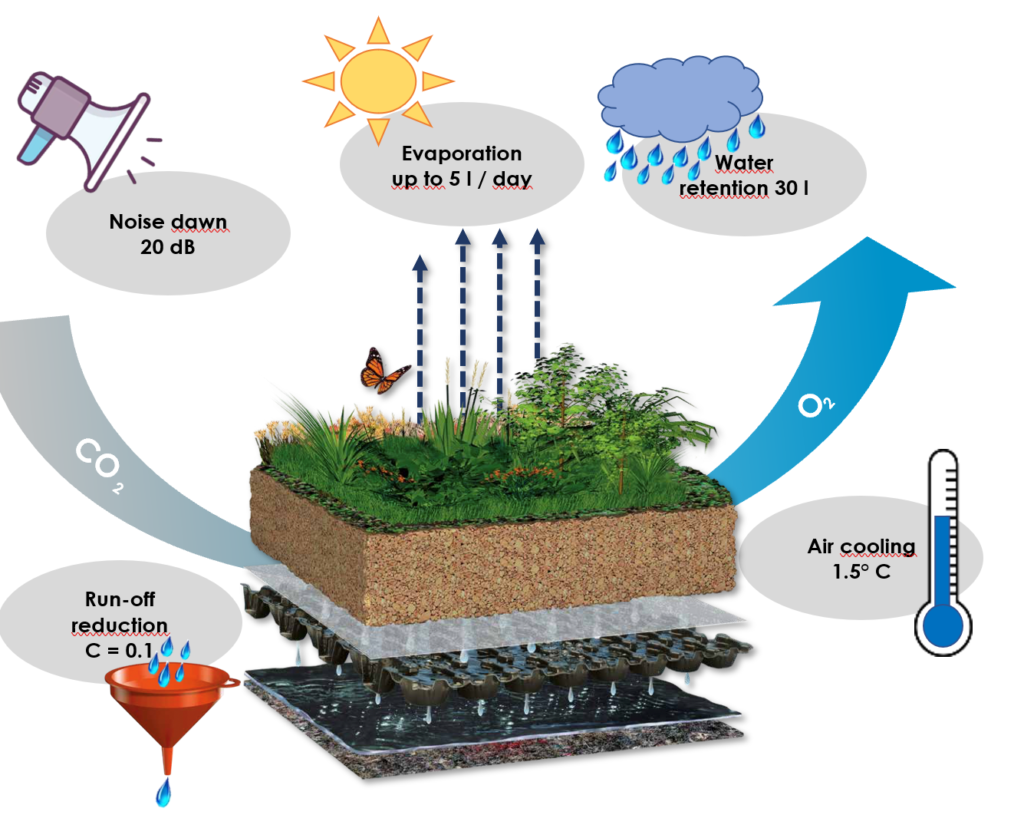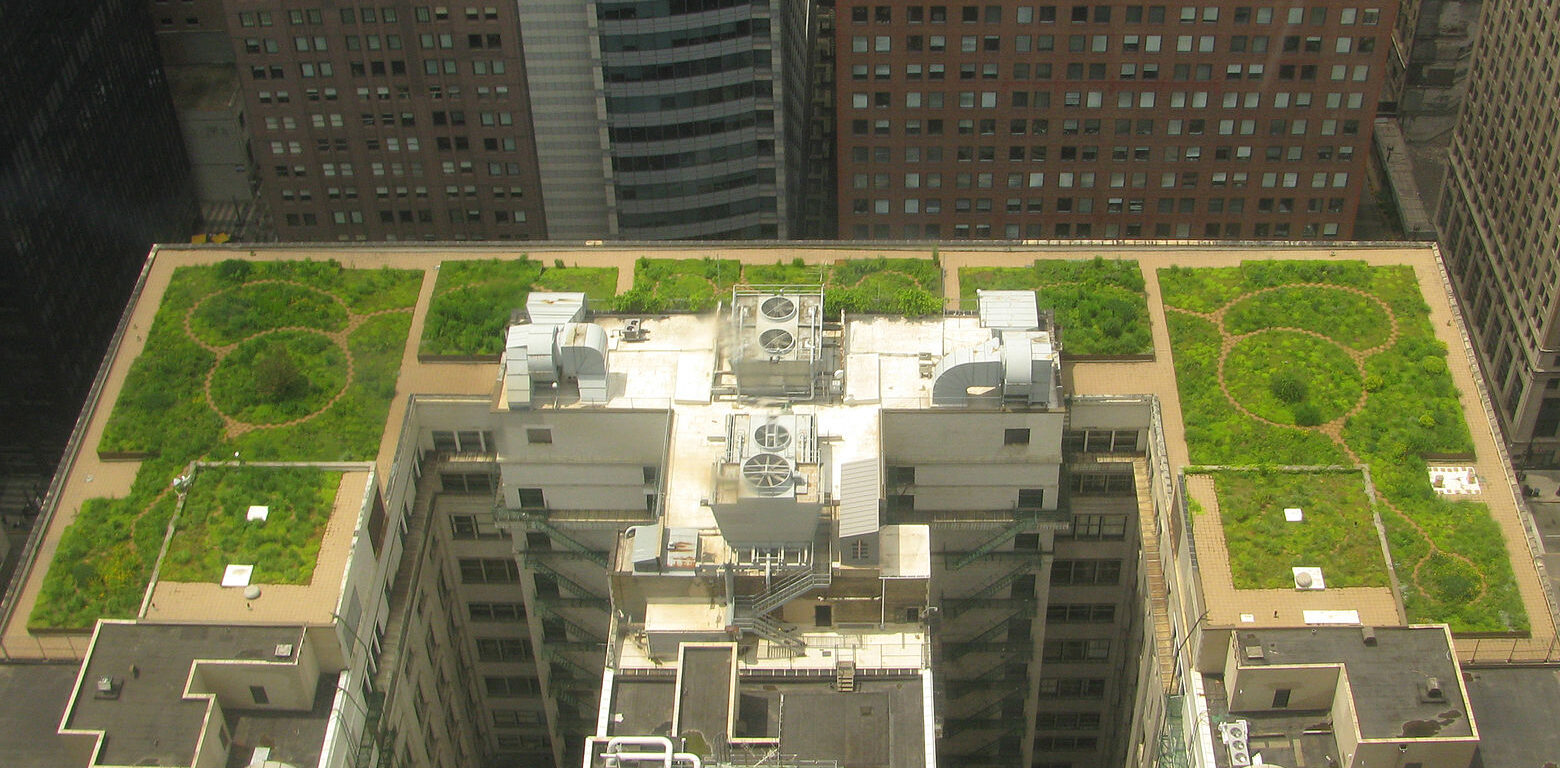We want to show people that green buildings are a service to our urban environment.
Leaves and branches act as natural dust filters for the city air. Green roofs are therefore a real contribution to ecological building. People should not underestimate this.
With this project we would like to make the population, especially large companies, aware of the need to change the climate and that big cities make a large part of it. Since there is not much room to plant trees in cities anyway, this can be done on large roofs.
We conducted three interviews with the “Schweizerische Fachvereinigung Gebäudebegrünung”, the “Grüne Dächer GmbH” and the “Paul Bauder AG”. These make up most of the content of the following text.
What is meant by green roofs?
Green roofs are a real alternative for roofing, and not just for carport and garage owners. But why? A green roof offers a whole range of advantages and few disadvantages. For a long time, we only knew green roofs from mossy roof tiles. And these were rather unintentional. Today, green roofs are created quite deliberately. Green roofs are green spaces on a roof of a building. The greenery of a roof is an installation of vegetation-compatible structures without a connection to the soil
Can any roof be turned into a green roof?
Consequently, not every roof can be greened. The greening of roofs requires prior clarification of statics, inclination (Neigung), waterproofing (Abdichtung), drainage (Entwässerung) (varies from municipality to municipality) and possibly a building permit. As the roof inclination increases, so do the construction and maintenance costs. Above an inclination of 30°, conventional roof coverings are generally more economical.
Why should we make our homes greener in the future? (advantages)
Green roofs have established themselves as a compensatory measure. They are a building block for adapting to the consequences of climate change. Green roofs have many positive effects on the climate and on flora and fauna. Besides creating a habitat for fauna and flora, green roofs offer improved insulation (Isolierung) and thus an optimized indoor climate in the building. The possibility of retaining precipitation water (Niederschlagswasser) in the vegetation layers and cavities (Hohlräume) and slowly releasing it into the connected sewerage system relieves the wastewater treatment plants and leads to sustainable drainage of the settlement. The effect on the microclimate through the transpiration performance of the vegetation improves the microclimate around the building and promotes the well-being and health of the people. The same applies to the binding of fine dust. Also, living in densely populated residential areas has a negative impact on the health of residents as global warming increases. This is mainly related to cardiovascular damage (Herz-Kreislauf-Schäden).

Are there also disadvantages?
The construction and maintenance of green roofs cause additional costs for the client. However, these costs can be easily offset by the system performance and the lifetime extension of the building fabric. However, with good planning, there are no or not many disadvantages.
To what extent does greening help with cooling?
The filling of the vegetation substrate prevents the direct impinging UV radiation directly onto the surface of the building. The hygroscopic vegetation substrate condenses air humidity due to the temperature fluctuations of day/night and of course due to precipitation events. The transpiration of the plants leads to evaporative cooling, surface temperature without greening up to over 80 °C with the green roof up to approximately 25 °C.
What does greening do for our environment?
Individual roof areas have a major impact on the climatic challenges of our world. A green roof becomes interesting and effective when it is planned and implemented on a larger scale. Besides cooling, green roofs also help for dust retention and air pollution control, sound absorption, habitat for insects and small animals, partly for birds and bee pasture. With a natural diversity of species and as high as possible biodiversity on the roofs, an ecological balance can be created.
Does a green roof also affect us humans?
As mentioned above, greening promotes people’s well-being and health. Usually, new buildings are extended right up to the roof, and green roofs have direct benefits for the people who live there. Likewise, there is the possibility of creating new local recreation zones in urban areas (e.g. Urban Gardening).
What are the different types of the greening of buildings?
The type of green roof depends on the permissible roof load and inclination. The spectrum of roofs ranges from extensive to intensive use.
The goal of extensive greening is near-natural vegetation with low land loads (geringe Flächenbelastung) and minimal maintenance requirements. Stand-forming plants are mostly sedum species and drought-resistant roof weeds.
In the case of intensive greening, roof gardens with seating areas, play areas, ponds, complete sports facilities or even car parking areas with appropriate access roads can be created. Various forms of vegetation are possible on the green roof, ranging from perennials (Stauden), shrubs and lawns to small trees.
The greening of facades is also possible and has similar advantages as mentioned above. It can be extended by using edible climbing plants and climbers.

How have green roofs developed in recent years?
Over the last 35 years, green roofs have spread and established themselves steadily and unnoticed. However, this statement is currently more or less true for neighboring countries (Germany and Austria). In these countries, more roofs have been greened due to adjustments of the legal requirements and goals as well as more intensive research. The end-user (e.g. building owners) in Switzerland has gained an increased focus on these potential areas through ongoing sensitization campaigns. Nevertheless, green roofs have achieved a high application rate for the covering of flat roofs. In connection with the development of sloping insulation, the flat roof with greenery has reached a safe and high-quality standard.
What do you need for a green roof and how much does it cost?
The essential step in the greening of roofs is planning. The clarification of the statics and other technical issues is mandatory. This effort and the use of technical materials and substrates lead to additional costs, which can only be determined through a planning process. In terms of materials, water storage and drainage systems, vegetation substrates and plants are needed for a green roof.
The reference value for the costs is a gravel fill (Kiesaufschüttung) to protect the roof membrane costs about CHF 10 to 20 per square meter. A green roof, on the other hand, is at least twice as expensive, costing approximately CHF 30 to 60 per square meter. Of course, the price quotations vary extremely depending on the size of the area.
Experience
In the beginning, we quickly decided which topic we would deal with. On the Internet, we saw that greening on the roofs is a current topic.
Unfortunately, we did not find a collaboration partner, so we were not able to work with teams from other countries.
We came up with the idea to interview companies that deal with green roofs. We set up questions in German and sent them to four different companies. One of the companies is located in Germany. Fortunately, we received a prompt response from three different companies. First, we had to translate the German version into English. With the knowledge of these companies, we were able to put together a text that gave a lot of informative information about green roofs. Overall, we had to research almost nothing on the Internet, because these interviews were already very extensive.
Reflection
We both think that green roofs are an important topic nowadays because there are many benefits.
When we look back on our project, we think we did a good job. In the beginning, we didn’t know much about this topic, but now we are definitely well-informed. As mentioned before, we got instructive information through the interviews. However, in the beginning, we had some difficulties to divide the work in time, but we could manage it well. Next time we think it would be better if we organize everything better at the beginning.
On the whole, we would not be here where we are at the moment without our cooperation. And the most important thing is that we enjoyed doing this project!
Thank you for reading! 😀
Kamanya Paheerathan & Karishma Mappalakayil
Sources
Intensive Dachbegrünung (ZinCo.CH)
Dachbegrünung: Vorteile und Nachteile von Gründächern (wohnglueck.de)
List of illustrations
Header image (commons.wikimedia.org)
Advantages of a green roof (self-made)
Example of a green roof (wikivisually.com)
Interviews
Interview Schweizerische Fachvereinigung Gebäudebegrünung – German (PDF)
Interview Schweizerische Fachvereinigung Gebäudebegrünung – English (PDF)
Interview Grüne Dächer GmbH – German (PDF)
Interview Grüne Dächer GmbH – English (PDF)
Interview Paul Bauder AG – German (PDF)
Interview Paul Bauder AG – English (PDF)
GD_Bauder_Systeme_CHD_0920_Druckbogen (PDF)
Other Contributions
Green walls for a green City! | Don’t Waste My Energy!
City Parks and their impact on the environment | Don’t Waste My Energy!
☷ See the project teams here »
☵ Some words about the contributions »
☴ Our sponsors and partners » (the-horse.education)

Dear Kamanya & Karishma
Your project is really interesting and shows great commitment!
I find it really interesting how we can turn something so common to something that helps our enviroment! I also find your calculation very interesting and it seems its quite expensive.
Overall amazing article!
Best Regards, Celine
Dear Kamanya and Karishma
Thank you for this great work and your commitment to the green city of the future. You are clearly showing the benefits of a green roof at economic, ecological and societal levels. Green roofs provide a rainwater buffer, is a habitat for flora and fauna, purifies the air, reduces the ambient temperature in our cities, saves energy and regulates the indoor temperature.
Great work!
Erich Steiner (SFG)
Your text is very incredible! Good job. Now I know much more about the benefits of green roofs.
Dear Kamanya and Karishma
Your project is really really interesting. I have heard of green roofs before but never in such detail and of course with information from people and companies who have experience with it. Thank you for your work, it was very interesting to read your contribution.
Kind regards
Anabel